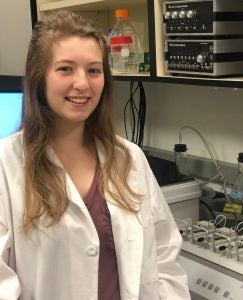January 16, 2019
Detrusor, Urothelium and Mitochodria – Oh My!
The following blog post by #ECUHonors junior Hanna Kosnik was originally posted by the Life Science Teaching Resource Community (Kayla Palmer, 2018 Dec. 14). Hanna is a recipient of the 2018 Undergraduate Summer Research Fellowship (UGSRF) funded by the American Physiology Society (APS). She conducts research under Dr. Johanna Hannan in the Department of Physiology (Brody School of Medicine) and plans to pursue a career in medicine.
 The summer of 2018, I worked under Dr. Johanna Hannan at Brody School of Medicine in order to study sex differences in bladder dysfunction and study the impact of obesity-induced bladder dysfunction. With one-third of Americans, aged 40 years or older, reporting to have some level of urinary incontinence, we know that bladder dysfunction is a common condition.1 Both males and females experience bladder dysfunction, but they can experience varying degrees of stress or urge incontinence, overactive bladder, and obstructed bladder. Overall, females experience greater urinary incontinence compared to males.1 Our other interest, obesity induced bladder dysfunction, is pertinent because an increased BMI correlates with a higher risk of urinary incontinence. The mechanism that obesity-induced bladder dysfunction occurs is poorly understood. Specifically, we looked at the urothelium, the inner lining of the bladder responsible for signaling, and the detrusor smooth muscle, which contracts the bladder to dispel urine. Our interest within these tissues were mitochondria, the powerhouse of the cell, responsible for creating ATP; mitochondria is a model indicator of cell health. To study the health of mitochondria, we measured mitochondrial respiration within mice urothelium and detrusor smooth muscle layers of the bladder. Different substrates were added to promote or inhibit certain pathways within oxidative phosphorylation so that differences in mitochondrial metabolism could be studied. We believe that impaired mitochondrial function is contributing to the decreased contraction and inflammation that leads to bladder dysfunction in obese men and women.
The summer of 2018, I worked under Dr. Johanna Hannan at Brody School of Medicine in order to study sex differences in bladder dysfunction and study the impact of obesity-induced bladder dysfunction. With one-third of Americans, aged 40 years or older, reporting to have some level of urinary incontinence, we know that bladder dysfunction is a common condition.1 Both males and females experience bladder dysfunction, but they can experience varying degrees of stress or urge incontinence, overactive bladder, and obstructed bladder. Overall, females experience greater urinary incontinence compared to males.1 Our other interest, obesity induced bladder dysfunction, is pertinent because an increased BMI correlates with a higher risk of urinary incontinence. The mechanism that obesity-induced bladder dysfunction occurs is poorly understood. Specifically, we looked at the urothelium, the inner lining of the bladder responsible for signaling, and the detrusor smooth muscle, which contracts the bladder to dispel urine. Our interest within these tissues were mitochondria, the powerhouse of the cell, responsible for creating ATP; mitochondria is a model indicator of cell health. To study the health of mitochondria, we measured mitochondrial respiration within mice urothelium and detrusor smooth muscle layers of the bladder. Different substrates were added to promote or inhibit certain pathways within oxidative phosphorylation so that differences in mitochondrial metabolism could be studied. We believe that impaired mitochondrial function is contributing to the decreased contraction and inflammation that leads to bladder dysfunction in obese men and women.
REALITIES OF RESEARCH
Working within a research lab is an experience you never forget. Life as a research scientist is different than what I had previously thought. It was not every day that I was running experiments; there were days where I read papers in order to understand and apply the results from the experiments. While we had originally believed that females would have decreased mitochondrial respiration because they had a higher prevalence of bladder dysfunction, the data obtained from an oxygraphy-2K (it measures oxygen within a chamber) showed that males actually had lower respiration. These results were found in the presence of a fatty acid which seems to impact male bladder metabolism. Though our hypothesis was proved wrong, our results are significant because they uncover novel information related to males having an impaired fatty acid metabolism.
The best part of working in a research lab was contributing to the field of science. Though our hypothesis was proved wrong, the data still had relevance to bladder dysfunction and how it impacts the population. Before our research, there was little to no information on bladder mitochondria in males and females. On the other hand, the worst part of research was when a machine would malfunction during the experiment. It not only compromised the results, but the tissue that was in it was also rendered compromised. Whenever this happened, there was always someone in the lab that I could ask for help. Also, this experience demonstrated that is it okay to ask for help – especially from people within the lab! They probably experienced the same problem and had their own tips and tricks to prevent it from happening again. Collaboration and discussion were encouraged in the lab; it is something I hope to continue to practice as I continue a career in science.
References
- org. (2018). American Urological Association – Bladder Health. [online]
FOLLOW & CONNECT ON TWITTER
ECU Brody School of Medicine @ECUBrodySOM
ECU Research @ECUREDE
Dr. Johanna Hannan’s Lab @Hannan_Lab
American Physiology Society @APSPhysiology
ECU Honors College @ECU_Honors
